Happy Thursday!
Today, I want to introduce to you all a wonderful new website for those of you who love historical embroidery and reproduction samplers, show you one of their charts, and point you to a really sweet free pattern that I want to use for a particular stitching technique.
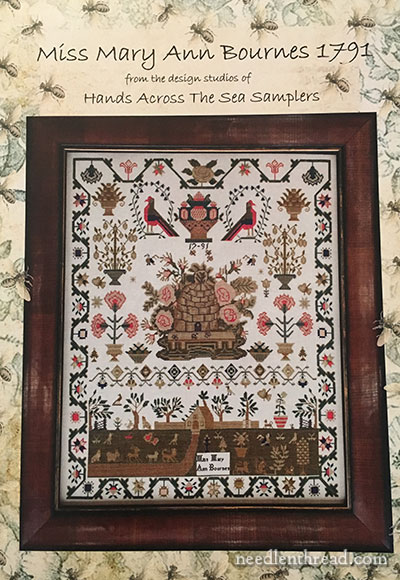
The website, run by Nicola Parkman in the UK, is called Hands Across the Sea Samplers. There, you’ll find charts for authentic reproductions of antique samplers like Miss Mary Ann Bourne’s sampler of 1791 above.
I’ve followed Nicola Parkman’s blog, Stitching by a Cornish Sea, for a long time, so I was really excited when she and Sandra (of Sampler Lovers) launched this new endeavor!
The charts they are producing a really nice!
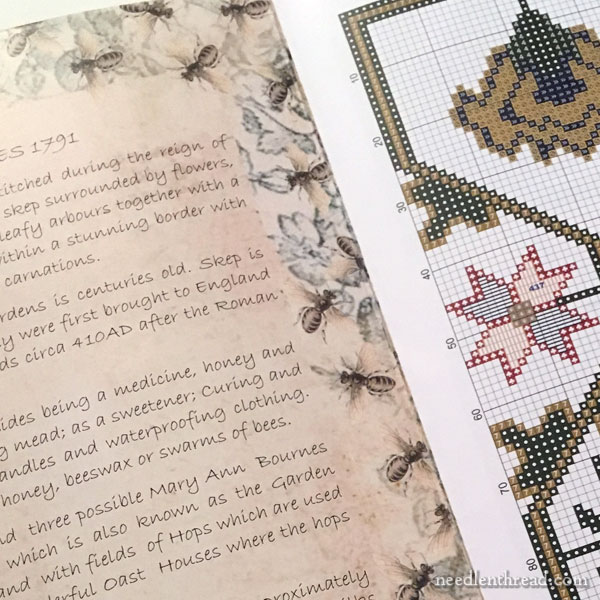
They’re printed in booklet form on heavy stock, and they begin with an introduction the sampler, including its history, how it was originally stitched, and other pertinent information.
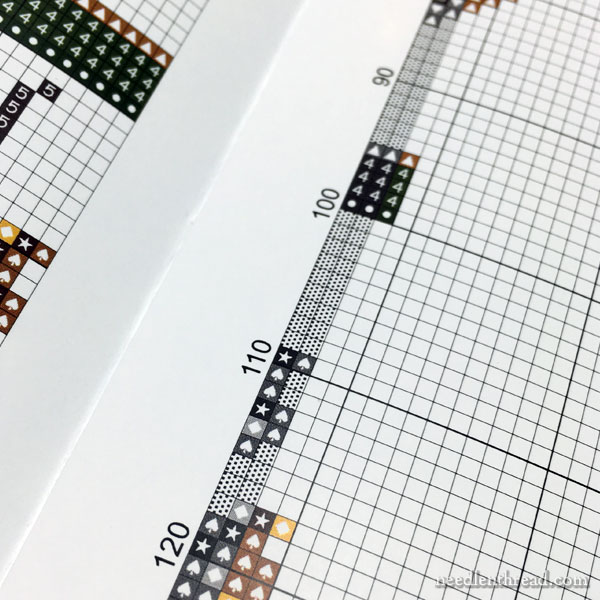
The charts are easy to read, and they include a shadowed overlap for each section, so that you don’t get lost as you move from section to section.
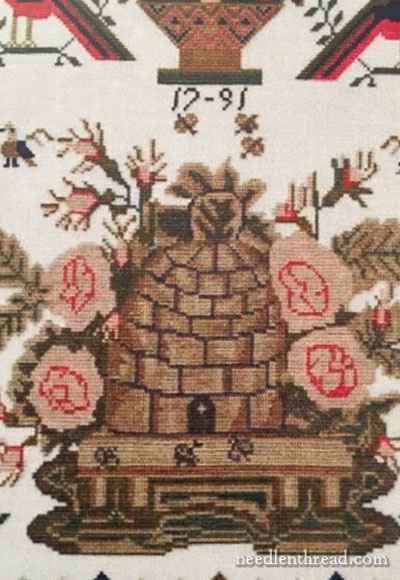
If you love bees (I personally have a Thing for the little buzzy critters), you’ll love the central motif of Miss Mary Ann’s sampler. It’s a bee skep, a-buzz with little bees and surrounded by lush roses.
The colors of the sampler are somewhat muted colors, suited to the historical time frame. The threads suggested for use are Au Ver a Soie’s Soie d’Alger, but they also supply a conversion chart for DMC. There are 15 colors in this particular sampler, and on the color list, you’ll also find the number of skeins needed to stitch the piece, along with fabric sizes needed for various counts.
In the back of the sampler booklet, you’ll find a tips page to help you complete the sampler, covering everything you need to know, including any specialty stitches.
This particular sampler is perfect for enthusiastic beginners and beyond!
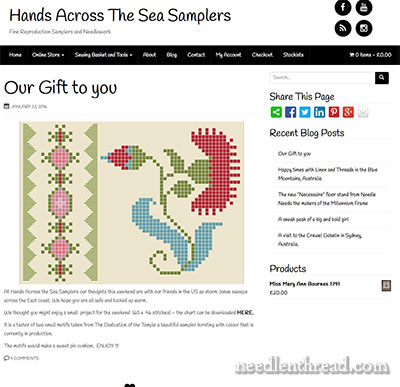
One very nice feature of the new Hands Across the Sea Samplers website is that they also have blog. And on that blog, they write about sampler stuff, stitching groups, shop talk, thread information and the like.
They also offer now and then a free pattern, like this gilliflower (carnation) design.
Which finally brings me to this point: I have a plan for that design! I love it! And I’m going to work it in bead embroidery. I’ll be showing you how in the upcoming week or so. It’s just a little design, perfect for beads, and it’ll make a nice little token to pass on to a friend, to make into a thank you note, a birthday card, or something special like that.
Can’t wait to show you! In the meantime, though, for sampler lovers everywhere, check out Hands Across the Sea Samplers – I think you’ll like it!
Hope you have a terrific Thursday!







Nicola and Sandra have done a fabulous job of their sweet reproduction. And I printed my copy of their generous freebie last weekend 🙂 I have plans too! Have a good weekend!
LOVE samplers! Used to do the counted cross stitch, but the old eyes just aren’t what they used to be and have a hard time with this. Are there any sampler patterns out there that AREN’T counted cross stitch? Just plain embroidery with stitches like stem, back, chain, satin, etc.? Have not been able to find any myself and thought you might know of a source.
Thanks for all you do and hope your health issues are improving!
Barbara in TN
Dear Mary
I’ve just had a look at their website very interesting, I’ve not heard of Hands Across the Sea but what lovely samplers especially if you are interested in historical embroideries. My favourite is the beehive really lovely sampler. Oh what a great idea bead embroidery, I love working with beads they are so pretty to work with. I can’t wait to see your progress on this project and for your ideas on beads and as you say a great idea for cards etc. Thanks for introducing us to Hands Across the Sea and for sharing their samplers with us.
Regards Anita Simmance
I wish there were more sampler patterns for non cross-eyed stitchers.
Thank you for another great link! Hope things are slightly less chilly in your part of the world and that weather and life are not knocking you around too badly. Call in your loved ones for support whenever you feel the need.
Mary, that’s a good idea! I look forward to seeing you work on this project, especially seeing what beads you choose.
The Scarlet Letter has been publishing graphs with this format for the past fifteen years. “Samplers Across the Sea” did not invent this. I shared it with Nicola Parkman.
Thank you Mary for your review of our first design – Miss Mary Ann Bournes.
We cannot wait to share with you several stunning samplers currently in production and due for release this year. All chosen especially for their beauty.
When putting together our designs and charts we have tried to make them unique and to do so from a stitcher’s point of view. We have taken features we love from charts we have enjoyed working from, added a few extras and got creative with our artwork to make each of our charts little individual gems to collect and cherish.
We are very open to input from our stitchers and will be pleased to hear from them with suggestions to make the charts even more enjoyable to work with.
Very soon we will be releasing our second chart and as a thank you to all our supporters we have uploaded to our website a free chart of a sweet motif taken from this sampler; it would be ideal for a bookmark.
I have dreamed of making a sampler for a very long time and there are so many nice patterns out there. So many, that I haven’t been able to narrow the choice down to *the* one!!
I love all the HATS charts although I will never get to stitch them all
One of the things I like most about them is that they are an accurate representation of the original, meticulously charted, and the charts are very clear and easy to read.
Some stitchers like to correct errors the little girls made or change stitches, colours and fabric but others like to stitch exactly as the original, feeling one with the girl. If a chart isn’t accurate how do you know if you are deviating!
Every HATS chart comes with a lot of researched background and great efforts are made to find the original stitcher and her story. If she cannot be traced then there are details of how life might have been in the times she lived.
In all my stitching life I have never seen such beautifully presented charts, they have become collectors items!
My real favourite is Mary Ann Bournes and I am now very privileged to be the owner and custodian of the original and never cease to admire the beautiful work she did.